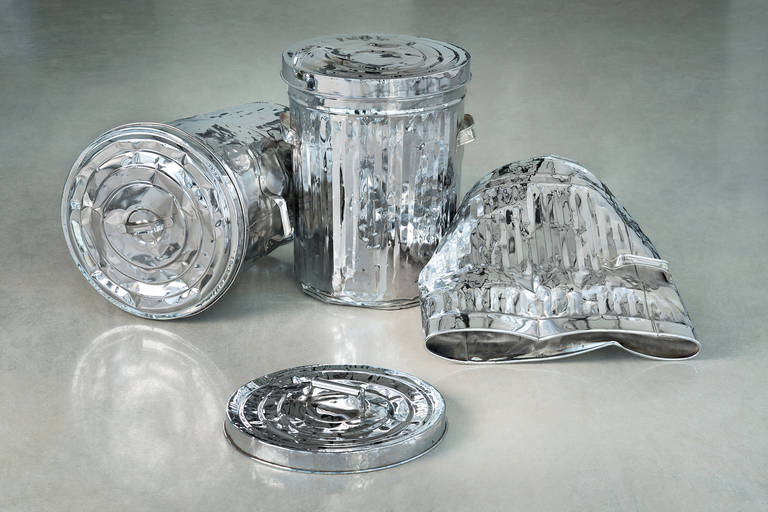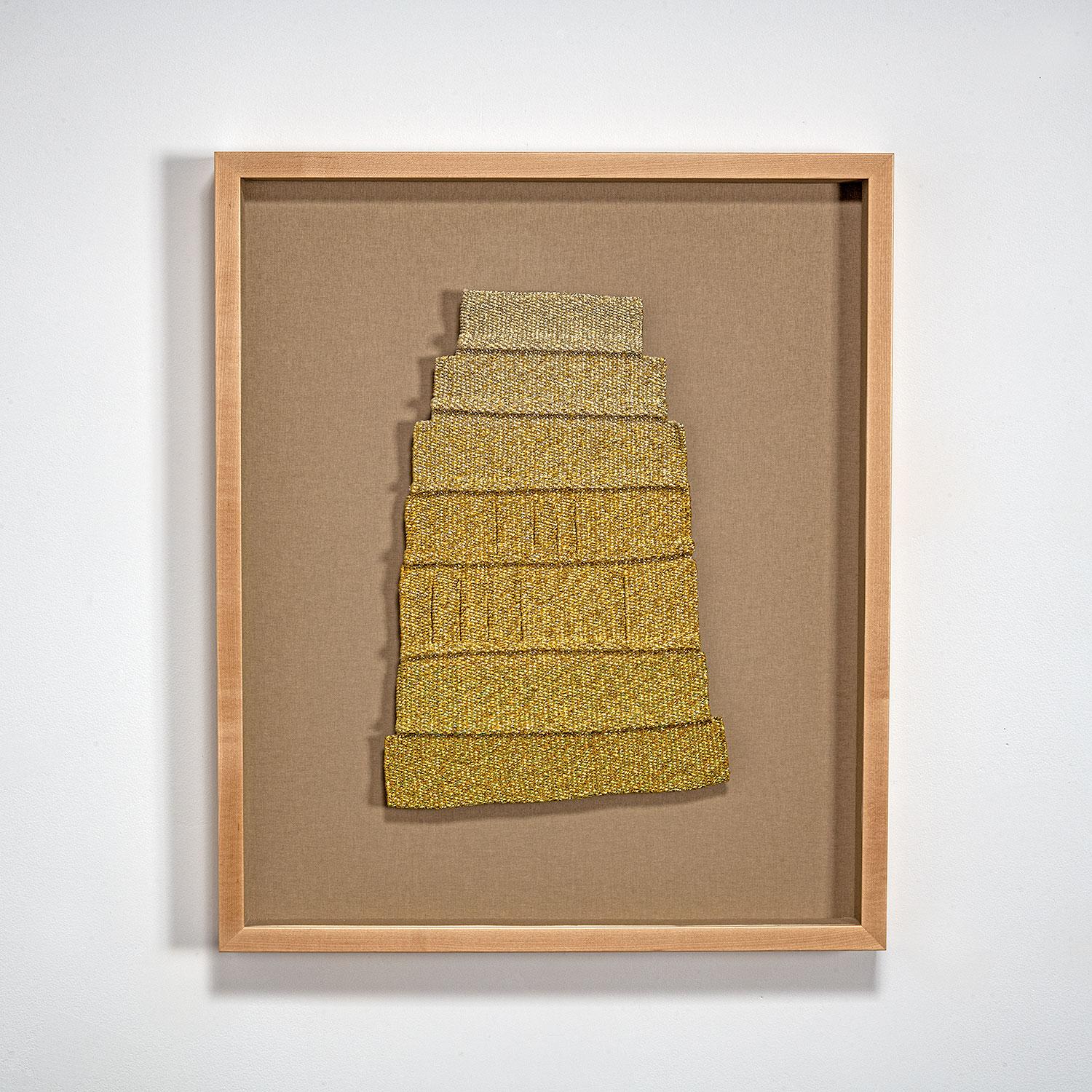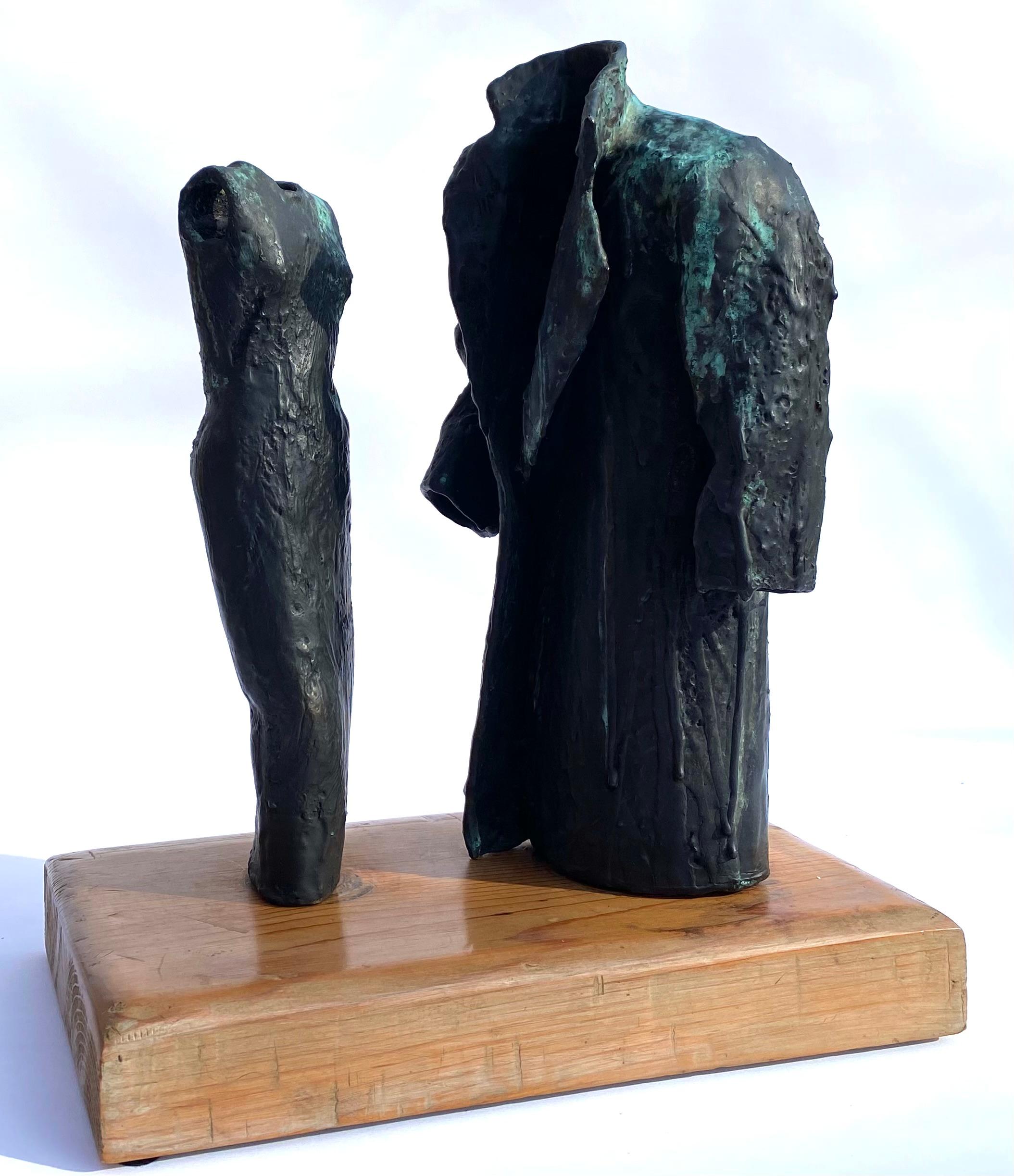Items Similar to Happy Meal
Want more images or videos?
Request additional images or videos from the seller
1 of 9
Zeke MooresHappy Meal2007
2007
About the Item
Text by Michelle Cantin-Reid
The common object reconstructed through skilful assembly and technique; casted, welded, and chased metal forms; almost perfect doppelgangers of the originals, this is how Zeke Moores’ work appears. Upon closer consideration, the materiality of these pieces comes to light. Deceivingly close to the real thing, they greatly diverge from the original.
From chromed steel Trashcans to the reconstructed Port-O-Potty made from cast aluminum and nickel-plated steel, Moores uses metalsmithing techniques to render his sculptures, usurping of the traditional modes of mass production as well as the disposable materiality that we associate with these objects. In his work, mechanised assembly line production and objects made to be thrown out or forgotten become a craftsman’s labour of love. As the disposable dejected everyday object is taken from the street and placed into the gallery, our use and imposition of a hierarchy on objects becomes apparent. However, it also speaks of the amount of work no longer done by people or often done by a series of anonymous workers in a repetitive but carefully choreographed dance with machines. We approach very differently a practical or a mass-produced object and one that is crafted.
These works also celebrate those objects designed for practical but not specifically aesthetic purposes. The imposition of a new materiality gives them durability and in the case of bronze casts or chrome plating a superficial prestige. Sitting in a gallery contemplated and beheld, the cast bronze Barrier is not unlike a monument or a statue. Though, these nobler materials are not wherein the beauty lies. Happy Meal’s precise metal fast food packaging form highlights the painstaking work that is cutting and assembling fabricated steel as opposed to the usually rapidly manufactured and disposable ones we know well. The nobility of the material is not important, and rather than simply elevating the common object, it prompts new readings.
Moores’ objects seem to hint at humour while remaining somewhat unsettling. His cast aluminum Axes have an altogether different relationship to their materiality. Moulded, casted, and multiplied through the process, they attack the gallery wall in their display as a tasteful graphic composition. The aluminum becomes a more subdued signifier than in many of the other pieces, though their process of fabrication stands out strongly.
Through these variations, studies, and experimentations dealing with materiality and objecthood, Moores’ sculptures hit on many aspects of our cultural, political and social economies. Their material deviations do not necessarily allow for immediate universal associations, and so ultimately, they are deceptive in their seeming simplicity.
- Creator:Zeke Moores (1977, Canadian)
- Creation Year:2007
- Dimensions:Height: 5 in (12.7 cm)Width: 14 in (35.56 cm)Depth: 12 in (30.48 cm)
- Medium:
- Movement & Style:
- Period:
- Condition:
- Gallery Location:Montreal, CA
- Reference Number:1stDibs: LU476148484
About the Seller
5.0
Vetted Seller
These experienced sellers undergo a comprehensive evaluation by our team of in-house experts.
Established in 1996
1stDibs seller since 2014
96 sales on 1stDibs
- ShippingRetrieving quote...Ships From: Montreal, Canada
- Return PolicyA return for this item may be initiated within 7 days of delivery.
More From This SellerView All
- Trash CansBy Zeke MooresLocated in Montreal, QuebecText by Michelle Cantin-Reid The common object reconstructed through skilful assembly and technique; casted, welded, and chased metal forms; almost perfect doppelgangers of the or...Category
21st Century and Contemporary Post-Modern Sculptures
MaterialsSteel
- CarrouselBy Guillaume LachapelleLocated in Montreal, QuebecGuillaume Lachapelle's artistic practice is shaped predominantly by sculpture, expressed in the form of installations and detailed miniature models. Lachapelle presents playful universes which combine objects of undetermined purpose; in this way, he opens the conventions of our reality to fresh disposition. The architecture of his models - which Lachapelle has recently begun to make with the help of the latest 3-D printing technology - shows motifs originating from the everyday, certainly, but seeming strange, alienating or even uncanny when combined as the artist chooses. A kind of transition between two worlds often appears in Lachapelle's work - for example when the model of a library filled with books curves inwards and reveals a mysterious opening pointing into darkness - these are the artist's references to spaces and occurrences which may be concealed below the surface of outward semblance. Guillaume Lachapelle has participated in several solo and group exhibitions including Manèges at Circa - Centre d'Exposition Art Contemporain (Montreal) in 2006; Quebec Gold at the Ancien Collège des Jésuites (Rheims, France) in 2008 and in Abracadabra (Edward Day...Category
21st Century and Contemporary Post-Modern Sculptures
MaterialsNylon
- ChimèreBy Guillaume LachapelleLocated in Montreal, QuebecGuillaume Lachapelle's artistic practice is shaped predominantly by sculpture, expressed in the form of installations and detailed miniature models. Lachapelle presents playful universes which combine objects of undetermined purpose; in this way, he opens the conventions of our reality to fresh disposition. The architecture of his models - which Lachapelle has recently begun to make with the help of the latest 3-D printing technology - shows motifs originating from the everyday, certainly, but seeming strange, alienating or even uncanny when combined as the artist chooses. A kind of transition between two worlds often appears in Lachapelle's work - for example when the model of a library filled with books curves inwards and reveals a mysterious opening pointing into darkness - these are the artist's references to spaces and occurrences which may be concealed below the surface of outward semblance. Guillaume Lachapelle has participated in several solo and group exhibitions including Manèges at Circa - Centre d'Exposition Art Contemporain (Montreal) in 2006; Quebec Gold at the Ancien Collège des Jésuites (Rheims, France) in 2008 and in Abracadabra (Edward Day...Category
21st Century and Contemporary Post-Modern Sculptures
MaterialsNylon
- La forêtBy Guillaume LachapelleLocated in Montreal, QuebecGuillaume Lachapelle's artistic practice is shaped predominantly by sculpture, expressed in the form of installations and detailed miniature models. Lachapelle presents playful universes which combine objects of undetermined purpose; in this way, he opens the conventions of our reality to fresh disposition. The architecture of his models - which Lachapelle has recently begun to make with the help of the latest 3-D printing technology - shows motifs originating from the everyday, certainly, but seeming strange, alienating or even uncanny when combined as the artist chooses. A kind of transition between two worlds often appears in Lachapelle's work - for example when the model of a library filled with books curves inwards and reveals a mysterious opening pointing into darkness - these are the artist's references to spaces and occurrences which may be concealed below the surface of outward semblance. Guillaume Lachapelle has participated in several solo and group exhibitions including Manèges at Circa - Centre d'Exposition Art Contemporain (Montreal) in 2006; Quebec Gold at the Ancien Collège des Jésuites (Rheims, France) in 2008 and in Abracadabra (Edward Day...Category
21st Century and Contemporary Post-Modern Sculptures
MaterialsNylon
- The CellBy Guillaume LachapelleLocated in Montreal, QuebecThe Architecture of Knowledge in the work of Guillaume Lachapelle L. Sasha Gora Jorge Luis Borges imagined the universe as a library, one “composed of an indefinite and perhaps infinite number of hexagonal galleries.” The bookshelves in Guillaume Lachapelle’s rigorously detailed, architectural miniatures are similar imaginings of knowledge, infinity, and the meaning of books. When Lachapelle predominantly sculpted with wood, the library was already present in his work. Take for instance the delicate shelves in Maneges (2004-2006). In 2009, he began to employ 3D printing and since, he has drafted bookshelves as white, intricately printed sculptures. Fissure, 2009, a bookshelf whose centre collapses, like quicksand, into a void; Le piège, 2009, an isolated balcony that protrudes from a bookshelf; Évasion 2, 2011, a fragile staircase that leads to a corridor library. Despite their sculptural form, these pieces never feel static. They suggest something beyond the shelves. Books are often described as gateways to other worlds and the artist Dominique Gonzalez-Foerster exemplifies this literally. In her 2013 La Bibliothèque clandestine at Palais de Tokyo what at first appears to be a bookshelf is actually a rotating door that opens into a secret gallery. For Lachapelle’s sixth solo exhibition at Art Mûr, Vision, we encounter again the library. This time, he employs single-sided mirrors to exaggerate a sense of the infinite, getting closer to Borges’ indefinite library, such as in Awaiting Knowledge (2013). We confront the same architecture in Metro (2013) and Last Night (2013). A library, a subway car and a hallway from the Titanic, respectively, all melt into an intriguing yet alarmingly dark void. Where does the darkness at the end of hall lead to? Lachapelle’s miniatures act as a threshold between what is seen and not seen. Although a good five centuries apart, the printing press and 3D printing both belong to the history of print. However, in Lachapelle’s miniatures, books are separated from their use. We cannot read them. They are rendered decorative, almost fetishized, and so instead we must mediate on their symbolism. This requires imagination. Lachapelle’s models are far too tiny for us to occupy physically, and so we must occupy them with our imagination, as when we occupy books, turning the words into the stories and images of people and places. In Borges’ story, what began as extravagant happiness - the Library of Babel housing all books and holding all of the world’s answers – turned to depression: “The certitude that some shelf in some hexagon held precious books and that these precious books were inaccessible, seemed almost intolerable.” For Lachapelle, books represent a similar anxiety: as much as we know, there is always more that we don’t. Guillaume Lachapelle's artistic practice is shaped predominantly by sculpture, expressed in the form of installations and detailed miniature models. Lachapelle presents playful universes which combine objects of undetermined purpose; in this way, he opens the conventions of our reality to fresh disposition. The architecture of his models - which Lachapelle has recently begun to make with the help of the latest 3-D printing technology - shows motifs originating from the everyday, certainly, but seeming strange, alienating or even uncanny when combined as the artist chooses. A kind of transition between two worlds often appears in Lachapelle's work - for example when the model of a library filled with books curves inwards and reveals a mysterious opening pointing into darkness - these are the artist's references to spaces and occurrences which may be concealed below the surface of outward semblance. Guillaume Lachapelle has participated in several solo and group exhibitions including Manèges at Circa - Centre d'Exposition Art Contemporain (Montreal) in 2006; Quebec Gold at the Ancien Collège des Jésuites (Rheims, France) in 2008 and in Abracadabra (Edward Day...Category
21st Century and Contemporary Post-Modern Sculptures
MaterialsNylon, Plexiglass, LED Light
- (various)By Clint NeufeldLocated in Montreal, QuebecClint Neufeld is a sculptor who works with concepts of masculine identity, currently in the form of ceramic transformations of engines and transmissions. Neufeld was born and rais...Category
21st Century and Contemporary Post-Modern Sculptures
MaterialsPorcelain
You May Also Like
- Dog with BirdBy David L. DemingLocated in Sante Fe, NMDavid L. Deming’s world of lively canine sculptures captures the artist’s love for dogs and presents a whimsical look at four-legged behavior at its best. His extensive and unique collection of painted steel and lacquered steel dog sculptures...Category
1990s Post-Modern Figurative Sculptures
MaterialsSteel
- Brasilian Edival Ramosa Engraved Steel and Black Plexiglass Linee di GioiaBy Edival RamosaLocated in Brescia, ITThe project of this engaging artwork was made in 1974 by the Brasilian artist Edival ramosa, during his stay in Italy, from 1964 to 1974. In this engraved steel artwork we can find e...Category
Late 20th Century Post-Modern Abstract Sculptures
MaterialsSteel
- Italy Post Modern Jiro Sugawara Aluminium Multiple Abstrac SculptureBy Jiro SugawaraLocated in Brescia, ITThis artwork was created by the artist Jiro Sugawara, the title is "Circle" Jiro Sugawara is a post-war artist and he was born in Japon in 1941. He studied sculpture at the Tokyo Dep...Category
Late 20th Century Post-Modern Abstract Sculptures
MaterialsSteel
- Gold Laugh, Post-Modern Metallic Woven Abstract Textile Sculpture/EmbroideryBy Micheline BeaucheminLocated in Wilton, CTGold Laugh (1980-85) metallic and acrylic thread, cotton. Gold, Metallic Woven Abstract Textile Sculpture. Textile artist, Micheline Beauchemin (1929-2009) was born in Longqueuil, Quebec, Canada. She has created a repertory of various works which includes theatre curtains, tapestries, wall hangings, embroidery murals, flexible walls, stained glass works, scale models, collages, toys, costumes and illustrations. Micheline Beauchemin began her career making stained-glass windows but early on turned to weaving and embroidering spectacular wall hangings in vibrant colors, including blues and greens. travelled and studied in Japan, China, India, North Africa, the Canadian Arctic and the Andes, adding depth and mystery to the love of light, water, wings and nets that is evident in her body of work. Beauchemin’s works are included in the collections of the National Gallery of Canada, Ottawa; the Montreal Museum of Fine Arts; the Musée du Québec; Pearson Airport, Toronto; the Canada Council, Ottawa; the Canadian Museum of Civilization, Gatineau; the Bibliothèque Centrale, Quebec; the Taxation Data Centre, Shawinigan; the Revenue Building, Québec; North York...Category
1980s Post-Modern Abstract Sculptures
MaterialsMetal
- “Eden”Located in Southampton, NYOriginal hand cast bronze dual figure of a hollow dressed torso of a male and female representing Adam and Eve in the Garden of Eden. The bronze sculpture is attributed to the American sculptor Judith Shea. This piece is a maquette for a life size bronze executed by this artist that is located in an outdoor space in Buffalo, New York. Both are titled “Eden” and were done in 1987. Condition is excellent. Unsigned. Label on the bottom of the thick pine base states the artist and title of the artwork. Provenance: A Long Island, New York collector. Judith Shea has been a notable presence in the New York art world since the 1970s. Trained as a designer at Parsons, she soon found the fashion industry too restrictive and abandoned it in favor of making art. For her first solo show, at The Clocktower in 1976, Shea made a work based on color theory, using transparent silks in a spectrum of colors, worn by a live model. Other early work referenced clothing and its construction, first as flat, minimalist pattern and later as molded draping over implied, absent figures. In the 1981 Whitney Biennial, Shea showed three simple forms that evoked iconic clothes of the 1950s and 60s—the overcoat and the simple sheath dress—which hung from the wall as if on hangers. Five related works were included in the Hirshhorn’s Directions 83 survey. All of these works evoke human presence, felt as absence, as if the clothes were placeholders for missing persons. Thinking about her earlier clothes-based works, Shea has said that she “was looking for characters, for personae, really, to occupy them. I used clothes as stand-ins for people.” With the support of NEA grants, Shea began to learn bronze casting, and she was able to also spend time in Paris studying the statuary of its parks and gardens. This research led to several hollow-figure compositions from the 1980s that were designed to be sited in public spaces, such as Eden (John Hancock Tower, Chicago), Shepherd’s Muse (Oliver Ranch), Shield (Sheldon Museum of Art), and Without Words (Walker Art Center). In the 1990s, after a residency at Chesterwood—the site of Daniel Chester French’s studio in Stockbridge—Shea began to use woodcarving to make monumental public sculpture. The first of these full-scale wooden figures were shown in 1992 at the Whitney Museum at Phillip Morris in New York. In 1994 her wooden equestrian statue The Other Monument, a monumental image of a black man on a black horse, was installed at Doris Freedman Plaza in New York, in the same plaza as the William Tecumseh Sherman...Category
1980s Post-Modern Figurative Sculptures
MaterialsBronze
- The Curious Child - Bronze by Isabelle LevesqueBy Isabelle LevesqueLocated in Pasadena, CALevesque Isabelle was born in 1954 in Antananarivo. She attended the school of fine arts of Brest (France) and practiced sculpture since 1997. She made her first official exhibition ...Category
21st Century and Contemporary Post-Modern Figurative Sculptures
MaterialsBronze


